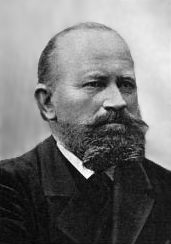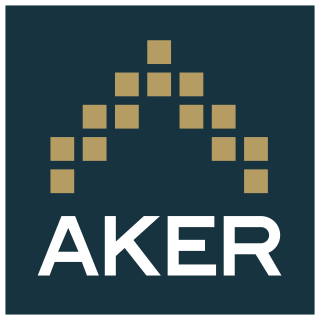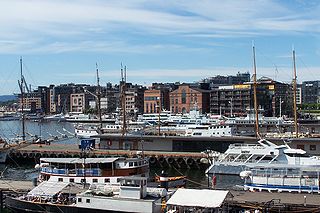
Amund Ringnes was a Norwegian businessman, brewery owner and patron.

Aker Solutions ASA is a Norwegian engineering firm headquartered in Oslo. The firm's production is focused on energy infrastructure, including systems and services required to de-carbonize oil and gas production, build wind-to-grid infrastructure and engineer CO2 capture and sequestration.

Kongesjaluppen (KSJ) Stjernen I is a 17 m (56 ft) motor launch formerly used by the King of Norway for short sea transport on official occasions. She was built by Akers Mekaniske Verksted in Oslo as build number 189 in 1899. Stjernen I was in royal service from 1899 until the German invasion of Norway in 1940. In German service for the duration of the war, she had been totally gutted and was eventually sold.
Framnæs shipyard was a former Norwegian shipbuilding and engineering firm headquartered in Sandefjord, in Vestfold county, Norway. Originally strongly linked to the whaling industry, in later years it entered into more versatile shipbuilding, including rigs and modules for the offshore business. It was incorporated in 1898 and was closed down in 1986.
The minelayer HNoMS Glommen was built for the Royal Norwegian Navy during World War I, as the lead ship of the two ship Glommen class of mine layers. Her sister ship was Laugen. Glommen and her sister ship were kept in service until the German invasion of Norway in 1940. Glommen surrendered to the Germans on 14 April 1940, and was rebuilt as a floating anti-aircraft battery. She was scuttled at Kirkenes in 1944 by the retreating Germans.

Aker ASA is a Norwegian industrial investment company with ownership interests concentrated in oil and gas, renewable energy and green technologies, industrial software, seafood and marine biotechnology sectors. The company is listed on Oslo Stock Exchange. Aker's main shareholder is Kjell Inge Røkke, who owns 68.2% per cent of Aker through his company TRG Holding AS. The corporate headquarters are located in Fornebu, Norway. Aker was established in 1841 when Akers Mekaniske Verksted was founded in Oslo.

Aker Brygge is a neighbourhood in central Oslo, Norway. Since the 1980s and 1990s, it has been a popular area for shopping, dining, and entertainment, as well as a high-end residential area. It was previously an industrial area.
Thunes Mekaniske Værksted A/S, Thune for short, was a Norwegian manufacturing company that among other things built locomotives. The production facilities were last located at Skøyen.

Norcem AS is a Norwegian manufacturer of cement, and subsidiary of HeidelbergCement. It has plants in Brevik and Kjøpsvik.

Tjuvholmen is a neighborhood in the borough Majorstuen in Oslo, Norway. It is located on a peninsula sticking out from Aker Brygge into the Oslofjord. It is located east of Filipstad and south of Vika. At the tip of the peninsula, next to the sculpture park, is an outdoor bathing area. The water leads out to the Inner Oslofjord.

Ole Martin Siem was a Norwegian businessman and World War II resistance member.
Ragnar Toralf Kalheim was a Norwegian trade unionist and politician for the Socialist Electoral League.

Sinfra was a cargo ship built in 1929 as Fernglen by Akers Mekaniske Verksted in Oslo, Norway, for a Norwegian shipping company. The ship was sold to Swedish owners in 1934 and to a French company in 1939, on the last occasion having her name changed to Sinfra.
Kaldnes Mekaniske Verksted was a Norwegian manufacturing company, best known for its shipyard.

Bergen Mekaniske Verksted, later Bergens Mekaniske Verksteder, was a shipyard in Solheimsviken in Bergen, Norway. Established in 1855, it later also built a drydock in Laksevåg. The company folded in 1991, but the yard in Laksevåg is still in use.
The Pelle group was a Norwegian resistance group that conducted acts of sabotage against the German occupation of Norway in Østlandet during the autumn of 1944.
Kristian Rambjør was a Norwegian businessperson.

Rikard Olai Kaarbø was a Norwegian businessperson and politician.
Haugesund Mekaniske Verksted (HMV) was founded in 1900 as a shipyard in the city centre of Haugesund. The shipyard was moved to the western side of Risøy in 1912. From around 1970 the business has been towards the offshore market, with the construction of modules, maintenance of ships and oil and gas offshore installations.











